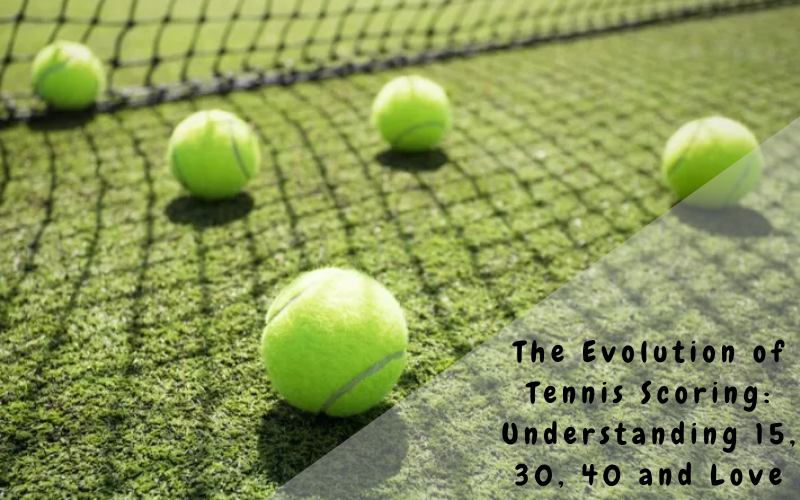Tennis scoring can be confusing to newcomers as it deviates from the standard numerical format of other sports. In tennis, each point earned is counted as 15, and subsequent points increase by 10, meaning the second point is worth 30, and the third point is worth 40. But why does the scoring system jump from 15 to 30 to 40?
This article aims to clear up any confusion and provide a better understanding of tennis scoring. Keep reading to learn more!
Table Of Contents
- Understanding Tennis Scoring: The Meaning Behind 15, 30, and 40 Points
- FAQ’s
- How and Why is a Tennis Game Scored 15-30-40? Explained.
- How are tennis points scored and why do they go up by 15?
- Why is the score in tennis 40 instead of 45?
- How Did the Term “Love” Come to Mean “Zero” in Tennis Scoring?
- What is the name of the first point in tennis?
- How Can You Hit A Winning Shot In Tennis?
- How Does Being Left-Handed Affect Tennis Gameplay?
- Conclusion
Understanding Tennis Scoring: The Meaning Behind 15, 30, and 40 Points
Are you looking for a clearer explanation of tennis scoring? The origins of the scoring system are uncertain, but it’s believed to have originated in medieval France.
The system is based on the movement of the minute hand on a clock and uses points of 15, 30, and 45 (later changed to 40) to keep score. If players tie, the score goes back to “deuce.”
When a player wins a point after deuce, they gain an “advantage.” If they win the next point, they win the game. The scoring system is as follows:
- 0 points = Love
- 1 point = 15
- 2 points = 30
- 3 points = 40
- Tied score = All
- 40-40 = Deuce
- Server wins deuce point = Advantage-In (Ad-In)
- Receiver wins deuce point = Advantage-Out (Ad-Out)
I hope this helps clarify the scoring system in tennis for you.

FAQ’s
How and Why is a Tennis Game Scored 15-30-40? Explained.
The scoring system in tennis is based on the quarters of a clock, with each quarter representing a score of 15, 30, 45, and 60. However, some find the number 45 to be too long and have suggested that it be shortened to “forty”.
If a player reaches “forty”, they must score two more points to win the game at 50 and 60. If they fail to do so, the score returns to “deuce”.
How are tennis points scored and why do they go up by 15?
The scoring system in tennis is unique, and it is based on the movement of the minute hand of a clock. For each 1/4th interval of the watch face, a score is awarded, and the first score is equivalent to 15.
Why is the score in tennis 40 instead of 45?
In tennis scoring, each quarter of the clock face represents a certain number of points. In the past, the score included 45, but it has been replaced with 40, meaning that players need two points to win instead of one.
When both players have a deuce score, the next two points will be counted as 10 points each. The first player to win a point will receive 10 points, and the clock will show 50. If they win the next point, the clock changes to 60, and the game is over.
However, if the opponent wins the next point, the score returns to deuce.
How Did the Term “Love” Come to Mean “Zero” in Tennis Scoring?
The origin of the term “love” in tennis can be traced back to a play on words between the English and French languages. The French word for egg, “l’oeuf,” resembles the number 0, which is the shape of an egg.
In English, “l’oeuf” is pronounced like “love,” which is how the term came to represent the score of 0 in tennis. Therefore, when the score is at 0, it is referred to as “love.”
What is the name of the first point in tennis?
In tennis, when both players have a score of 40-40, it is called a “deuce.” The next point is called the “advantage” point, and the player who wins that point is said to have the “advantage.” If the same player wins the next point, they win the game.
However, if the opponent wins the next point, the score goes back to deuce, and the players must continue playing until one player wins two points in a row to become the overall winner. This means that the player must have a lead of at least two points to win the game.

How Can You Hit A Winning Shot In Tennis?
When it comes to winning shots in tennis, there are several options depending on the situation and the player’s preference. A winning shot is any shot that the opponent cannot return. Here are some common types of shots that players use to win points in tennis:
- Serve
- Forehand
- Backhand
- Volley
Each of these shots can be executed in a variety of ways depending on the player’s technique and skill level. It’s important to practice each shot to improve your chances of hitting a winning shot during a match.
How Does Being Left-Handed Affect Tennis Gameplay?
Left-handed players can indeed have an advantage in tennis if they know how to use it effectively. Due to the rarity of left-handed players, right-handed opponents often struggle to anticipate their ball path and playing style, leading to a potential advantage for the left-handed player.
However, experience remains the most crucial factor in tennis success. Since left-handed players only make up 10% of the world’s population, right-handed players have little experience playing against them, and this lack of experience can be advantageous for left-handed players.
Conclusion
If you were wondering why tennis scores go from 15 to 30 to 40, this article has provided the answers. In summary:
- The score in tennis is based on the movement of the minute hand on the clock face.
- A score of 0 is called “love.”
- To win, players need to score 40 points and win points consecutively.
- Any shot that the opponent cannot return is considered a winning shot.
If you have any additional questions, please don’t hesitate to leave a comment.

